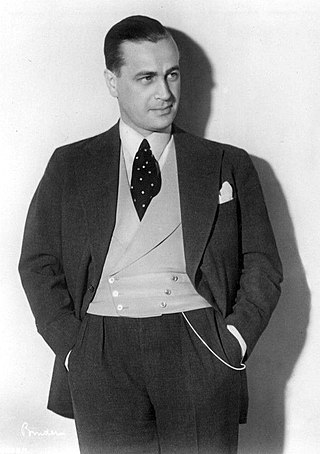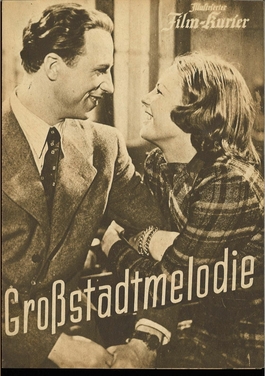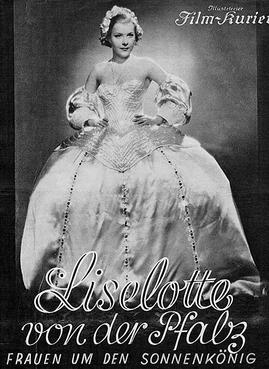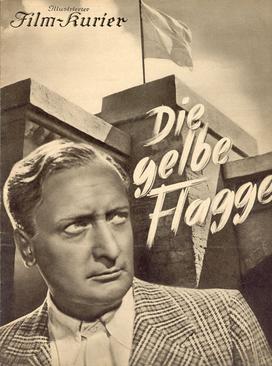
Gustav Diessl was an Austrian artist, and film and stage actor.

Werner Hinz was a German film actor who appeared in 70 films between 1935 and 1984.

Karl Ludwig Diehl was a German film actor. He appeared in 66 films between 1924 and 1957. His father was Karl Diehl, the German professor of Anarchism.
The Dismissal is a 1942 German film directed by Wolfgang Liebeneiner about the dismissal of Otto von Bismarck. It was one of only five films to receive the honorary distinction "Film of the Nation" by the Reich Propaganda Ministry Censorship Office.

The Swedish Nightingale is a 1941 German musical film directed by Peter Paul Brauer and starring Ilse Werner, Karl Ludwig Diehl, and Joachim Gottschalk. The film is based on a play by Friedrich Forster-Burggraf set in nineteenth century Copenhagen. It portrays a romance between the writer Hans Christian Andersen and the opera singer Jenny Lind, the "Swedish Nightingale" of the title.

The Great and the Little Love is a 1938 German comedy film directed by Josef von Báky and starring Jenny Jugo, Gustav Fröhlich, Rudi Godden. Jugo plays a stewardess working for Lufthansa. It was shot at the Johannisthal Studios in Berlin with sets designed by the art directors Karl Weber and Erich Zander. It was filmed partly on location around Genoa in Italy.

Land of Love is a 1937 German romance film directed by Reinhold Schünzel and starring Albert Matterstock, Gusti Huber and Valerie von Martens. It was shot at the Bavaria Studios in Munich and the Johannisthal Studios in Berlin. The film's sets were designed by the art directors Wilhelm Depenau, Kurt Dürnhöfer and Ludwig Reiber. Although Schünzel was Jewish he had been allowed to continue directing films in Germany after the Nazi takeover. However, this film faced objections from the censors and from Joseph Goebbels. It was briefly shown and then disappeared from cinemas. It was Schünzel's final German film as director, and he went into exile shortly afterwards.

Melody of a Great City is a 1943 musical drama film directed by Wolfgang Liebeneiner and starring Hilde Krahl, Werner Hinz and Karl John. A young woman moves to Berlin to work as a press photographer.

Clarissa is a 1941 German romance film directed by Gerhard Lamprecht and starring Sybille Schmitz, Gustav Fröhlich and Gustav Diessl. Schmitz plays the domineering manager of a bank who eventually falls in love with one of the other employees.

The Private Life of Louis XIV or Liselotte of the Palatinate is a 1935 German historical film directed by Carl Froelich and starring Renate Müller, Eugen Klöpfer and Maria Krahn. It was shot at the Tempelhof Studios in Berlin and premiered at the city's UFA-Palast am Zoo. The sets were designed by the art directors Walter Haag and Franz Schroedter. The film's English language release title is a reference to the hit British film The Private Life of Henry VIII (1933).

The Yellow Flag is a 1937 German drama film directed by Gerhard Lamprecht and starring Hans Albers, Olga Chekhova and Dorothea Wieck. It was shot at the Babelsberg Studios in Berlin. The film's sets were designed by the art director Ludwig Reiber. Location filming took place in Yugoslavia.

Two Times Lotte is a 1950 West German film, directed by Josef von Báky and starring Antje Weisgerber, Peter Mosbacher, Isa, and Jutta Günther. It was made by Bavaria Film at the Emelka Studios near Munich, and its sets were designed by the art directors Robert Herlth and Willy Schatz.

Confessions of Felix Krull is a 1957 West German comedy and drama film directed by Kurt Hoffmann and starring Horst Buchholz, Liselotte Pulver, and Ingrid Andree. It is based on the 1954 novel of the same title by Thomas Mann. The story was later made into a 1982 television series The Confessions of Felix Krull. It was shot at the Wandsbek Studios in Hamburg and on location in Lisbon. The film's sets were designed by the art director Robert Herlth. Mann's novel was made into a movie again in 2021.

Alarm is a 1941 German crime film directed by Herbert B. Fredersdorf and starring Karl Martell, Maria von Tasnady and Paul Klinger. The production was made by the independent Aco-Film rather than one of Germany's major film companies. It was shot at the Althoff Studios and various locations around Berlin including Tempelhof Airport and the Karstadt Department Store. The film's sets were designed by the art director Bruno Lutz.

The Court Concert is a 1948 German musical comedy film written and directed by Paul Verhoeven and starring Elfie Mayerhofer, Hans Nielsen and Erich Ponto. In the United States it was released as Palace Scandal.

Men Are That Way is a 1939 German drama film directed by Arthur Maria Rabenalt and starring Hertha Feiler, Hans Söhnker and Hans Olden. The film's sets were designed by the art director Willi Herrmann. It was remade by Rabenalt in Austria as Arena of Fear (1959).

I Am Sebastian Ott is a 1939 German crime film directed by Willi Forst and starring Forst, Gustav Diessl and Trude Marlen. Some of the film was shot by the assistant director Viktor Becker. It was shot partly at the Sievering Studios in Vienna. It premiered at the Gloria-Palast in Berlin shortly before the outbreak of the Second World War. The film's sets were designed by the art director Kurt Herlth and Werner Schlichting. The plot revolves around art fraud with Forst playing the dual role of twins, one honest and the other corrupt.

In the Employ of the Secret Service is a 1931 German drama film directed by Gustav Ucicky and starring Brigitte Helm, Willy Fritsch, and Oskar Homolka. It concerns espionage between Germany and Russia during the First World War. It was made at the Babelsberg Studios in Berlin with sets designed by the art directors Robert Herlth and Walter Röhrig. Location shooting took place in Denmark.

Bandits of the Autobahn is a 1955 West German crime film directed by Géza von Cziffra and starring Eva Ingeborg Scholz, Hans Christian Blech and Paul Hörbiger.


















